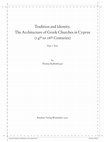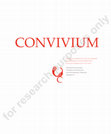Books by Thomas Kaffenberger

eds. Michele Bacci, Natalia Chitishvili, Gohar Grigoryan, Thomas Kaffenberger, Manuela Studer-Karlen, Vesna Scepanovic, 2023
Analyzing some of the most remarkable images, buildings, and spaces in the Southern Caucasus betw... more Analyzing some of the most remarkable images, buildings, and spaces in the Southern Caucasus between Late Antiquity and the Middle Ages, this volume is an invitation to see Subcaucasian sacred spaces from the vantage point of their early devotees and beholders. These essays follow a series of case studies ranging from the division of space in churches to the liminal borders of these divisions, to pilgrimage dynamics,
images, and liturgy. The authors of this volume investigate the ways in which different socio-cultural groups living in the Caucasian area interacted not only through their artistic and architectural projects, but also conceptually and intellectually through divergent
theories and practices concerning living spaces, communal shared heritages, and the human as well as the supranatural spheres.

Art history has often attempted to understand past cultures through an investigation of the most ... more Art history has often attempted to understand past cultures through an investigation of the most elaborate parts of their artistic legacy. However, in times of an increased interest in anthropological, socio-historical questions, the apprehension of the material legacy of past cultures in general becomes necessary. This fosters the exploration of previously unstudied corpuses of objects, buildings, which can provide us with most valuable insights into the functioning of past societies.
One of those corpuses, never comprehensively studied, are the over 300 Greek churches built or profoundly altered on the island of Cyprus under Latin/ Venetian rule between the early 14th century and the Ottoman conquest of 1571, so in a climate of multifaceted cultural encounters and exchanges. This material legacy was now for a first time systematically recorded and documented. The core of the present study is thus formed by the catalogue volume, presenting an in-depth analysis of construction phases and stylistic characteristics for 261 preserved churches, as well as commentaries on 54 further buildings only known through descriptions or pictorial sources. The text volume addresses the historical and artistic context by applying various methodologies to the studied material. After an introduction, disburdening the churches from previous biased or misleading scholarly verdicts, the foundations are set with a look at the development of local church architecture before the Latin conquest and a detailed chapter on typologies of plans, decorative elements or transformation processes. The next chapters focus on the analysis of stylistic developments – most importantly, the exchange between Western, Gothic and Eastern, Levantine architectural idioms and their formal impact on local Byzantine traditions. A recurring topic in the island’s architecture is the inclination to aesthetic regresses to periods long past, leading to the first of two keywords indicated already in the title: tradition. It is asked in which way a sense of tradition constructed, perpetuated, and multiplied through the design of churches. Ultimately this leads to the discussion of individual and collective identities and the way those were negotiated with the help of architectural works within the multicultural and multiconfessional Cypriot society. Thus, the study constitutes an important contribution to the apprehension of dynamics of cultural exchange in late medieval eastern Mediterranean.

Situated between the mountain ranges of the Caucasus, the country of Georgia was constantly expos... more Situated between the mountain ranges of the Caucasus, the country of Georgia was constantly exposed to contacts with both nearby cultures and such far-away realities as the Eastern Mediterranean and Western Europe. Constant political changes, including relations to and occupations by the neighboring empires of Byzantium and the Seljuks, make the region a prime example for the investigation of the dynamics of artistic exchange during the medieval period. This volume re-approaches the impressive material legacy from the medieval period in Georgia with a variety of new methodological approaches. The ten articles in this volume discuss, among others, general questions of cultural interaction, analyze the relation of liturgy and artistic objects, reexamine famous monuments and present a wide range of unpublished material.
Zwischen den Bergketten des Kaukasus gelegen, stand Georgien stets im Kontakt sowohl mit benachbarten Kulturen als auch mit weit entfernten Gebieten wie der Levante und Westeuropa. Stetige politische Umbrüche, darunter Beziehungen zu und Eroberungen durch die benachbarten Reiche der Byzantiner und Seldschuken, machen die Gegend zu einem Vorzeigebeispiel für das Studium der Dynamiken künstlerischen Austausches im Mittelalter.
Dieser Band nähert sich den immensen materiellen Zeugnisse aus dieser Periode in Georgien wieder an, unter Verwendung einer Auswahl neuer methodischer Zugänge. Die zehn Beiträge des Bandes besprechen, unter anderem, Fragen kultureller Interaktion, untersuchen die Zusammenhänge zwischen Liturgie und Kunstwerken; unterziehen bekannte Monumente einer neuen Betrachtung und stellen eine breite Auswahl bislang unpublizierten Materials vor.

Bild und Raum sind in der Analyse historischer Objekte und Konstellationen kaum voneinander zu tr... more Bild und Raum sind in der Analyse historischer Objekte und Konstellationen kaum voneinander zu trennen, sondern durchdringen sich vielmehr notwendigerweise wechselseitig und interagieren: Bilder wirken in und auf den Raum, Räume werden maßgeblich von Bildern konstituiert und bestimmen unser Verhältnis zu ihnen.
Der Sammelband untersucht anhand historischer Fallbeispiele die Potentiale verschiedener Raum- und Bildbegriffe für die Deutung einzelner Kunstwerke. Bild und Raum werden zudem als komplexe Sinnstrukturen aufgefasst, deren Realisierung auf das konkrete Handeln und Wahrnehmen der jeweiligen Akteure, seien es nun Maler, Architekten, Schauspieler, Auftraggeber, Museumsbesucher oder Kuratoren, angewiesen ist.
Die Beiträge des Bandes sind zu drei thematischen Gruppen geordnet: Die Räumlichkeit der Bilder. Raumstrukturen in zweidimensionalen Medien (I), Translationen und Interventionen. Orte - Räume - Bildmotive (II), Die Bildlichkeit der Architektur. Bauten und ihre Bilder (III).

Heinrich Metzendorf (1866–1923) ist heute vor allem als Architekt von zahlreichen gediegen-repräs... more Heinrich Metzendorf (1866–1923) ist heute vor allem als Architekt von zahlreichen gediegen-repräsentativen Villenbauten der Jahrhundertwende entlang der Bergstraße zwischen Darmstadt und Heidelberg bekannt. Sein Werk ist jedoch wesentlich vielgestaltiger als meist angenommen. So umfasst es neben Entwürfen für den Siedlungsbau, öffentlichen Bauwerken, wie Schulen und Rathäusern, Sakralbauten und Fabrikanlagen auch Aussichtstürme, Grabmale, Gartenanlagen und Raumensembles.
Der vorliegende Band stellt Metzendorfs Werk erstmals in seiner gesamten Vielfalt anhand meist noch unveröffentlichten Planmaterials vor und ordnet einzelne Werke in ihren kunst- und kulturhistorischen Kontext zwischen Historismus, Jugendstil und Reformarchitektur ein. Dabei versteht sich der Band einerseits als Monographie zur Person Heinrich Metzendorfs und den Arbeiten seines Architekturbüros, andererseits als exemplarische Studie zur Rezeption moderner Gestaltungsideen und Weltanschauungen in der Peripherie einer Kunstmetropole, wie sie das nahe Darmstadt um die Jahrhundertwende war.
Articles by Thomas Kaffenberger
Approaches to Sacred Space(s) in Medieval Subcaucasian Cultures, 2023
This study reapproaches an important monastery in Georgia, which contains buildings from the 7/8t... more This study reapproaches an important monastery in Georgia, which contains buildings from the 7/8th c. to the late Middle Ages. Located in a particular natural setting, it is surrounded by natural sites and built structures which came to be connected to the monastery and charged with functions as places of intercession, devotion or 'sacred' defence. The article in a first step follows the gradual development of this space of connected sacred locations into a sacred topography. The last part then gives an outlook onto other multi-church monasteries in Georgia and Armenia and their similarly differentiated topographical and functional developments.
Peregrinations, 2023
A study of the ruined remains of the former Dominican Monastery in Famagusta, focusing on the sca... more A study of the ruined remains of the former Dominican Monastery in Famagusta, focusing on the scant material evidence and revieweing previously expressed opinions on textual sources, to gain insight into the functioning of a little-studied mendicant site in the Levant.
New Approaches towards Recording, Preserving and Studying Cultural Heritage in Divided Cyprus: Problems & Opportunities, 2023
A study of five previously unpublished churches on the Karpas peninsula in Cyprus, revealing patt... more A study of five previously unpublished churches on the Karpas peninsula in Cyprus, revealing patterns of (re)establishment of a complex sacral microtopography through local shrines. With the church of Profitis Daniel in Rizokarpaso the study includes one of the oldest dome hall churches on the island.
PDF only contains the first page due to copyright restrictions.

Frankokratia, 2023
This study investigates bell-bearing structures and their historical context in Cyprus.
The aim i... more This study investigates bell-bearing structures and their historical context in Cyprus.
The aim is to shed light on when and in which ways bells were introduced into Greek
religious practice on the island, taking into account that they are often a sign of cul-
tural exchange between Latins and Greeks in other areas of the Mediterranean. This
shall be achieved through a focus on the material evidence preserved from mainly
Greek buildings from ca. 1200-1571, compared with buildings of other rites on the
island and complemented by manifold textual evidence predominantly from the Latin
sphere. It is shown how bells and the traditional Greek semantron were used in paral-
lel from at least the thirteenth century on, first enriching urban soundscapes of cities
like Famagusta and furthermore enabling a more diversified call to liturgies and other
events mainly in monastic environments.

Journal of Eastern Mediterranean Archaeology and Heritage Studies, 2021
Th e following article approaches a historic monument
on the island of Cyprus, the sixteenth-cent... more Th e following article approaches a historic monument
on the island of Cyprus, the sixteenth-century Panagia
tou Potamou church, with an interdisciplinary methodology.
An in-depth study of its history, architecture, and
paintings leads to a new evaluation of the church’s value
for Cypriot and Mediterranean research. Th e church has
proven to be a space for burial and private memory of
a sixteenth-century semirural community, refl ected in
the staging of a prominent burial and the iconographic
topics underlining ideas of intercession and salvation.
Ultimately, this enables an enhanced appreciation of
“minor monuments” in general. Th e other angle of
approach concerns heritage questions: in precarious
state for most of the twentieth century, particularly the
wall paintings are in urgent need of restoration. In 2015–
2017, an emergency intervention secured the most fragile
parts and evaluated the state of the church, proposing
future ways to ensure the survival of this monument.
Parerga. Pour Victor I. Stoichita, 2022
The article discusses the 13th c. paintings of Saint Lawrence Church in Paspels, Grisons, Switzer... more The article discusses the 13th c. paintings of Saint Lawrence Church in Paspels, Grisons, Switzerland. They display rather common scenes such as Christ surrounded by the Evangelist symbols and Apostles but also a paradise and hell reference on the triumphal arch. It is argued that part of the quality of these paintings lies in the use of the space as means to add multiple layers of readability particularly to the figure of Christ, who serves as Pantocrator just as much as Christ Judge in a non-explicitly shown Judgement. Furthermore, the church bears one of the oldest cycles dedicated to Saint Lawrence.

Convivium: Georgia as a Bridge Between Cultures Dynamics of Artistic Exchange, 2021
Abstract – Liminal Spaces of Memory, Devotion and Feasting?
Porch-Chapels in Eleventh-Century Geo... more Abstract – Liminal Spaces of Memory, Devotion and Feasting?
Porch-Chapels in Eleventh-Century Georgia – Around the
year 1000, a specific and unique type of sacred structure emerged
in Georgia: the porch-chapel. Five fully developed examples are
considered here: K’umurdo, Manglisi, Zemo-K’rikhi, K’atskhi,
and Samtavro Monastery. Typological study finds antecedents
in buildings of Late Antiquity and the early medieval buildings
of Tao. A “functional reading” leads to possible connections to
parallel phenomena in adjacent cultural spheres. The porchchapels,
this study finds, are liminal spaces of memorial purpose
that might have served for semi-secular feasts and private services
as much as they served as places of legal character. They appear
to have been one of the many architectural phenomena of the
period closely related to the liturgical shift from Jerusalemite to
Constantinopolitan liturgy.
The Art and Archaology of Lusignan and Venetian Cyprus (1192-1571), 2019

Das Kirchenportal im Mittelalter, 2019
In the study of late medieval architecture in Cyprus, portals play a crucial role. It is in their... more In the study of late medieval architecture in Cyprus, portals play a crucial role. It is in their comparatively lavish decorative treatment that, during the 14th century, the appropriation and transfer of western-gothic forms in the context of Greek church architecture on the island becomes manifest in the most striking manner. The Cypriot art of decorative portals culminates and ends at the same time with the Greek cathedral of the Panagia in Nicosia. Built in the 14th century and heavily altered on serval occasions, the church was finally used as Turkish Bedestan. During the 16th century, the building received no less than six sophisticated portals in its western and northern facades, which were executed in a distinctly medieval stylistic idiom and which raise fundamental questions also with respect to the interpretation of the entire building. In a first step, the portals will be discussed regarding their form: even though they all exemplify the artistic continuity in 16th century Cypriot architecture, no two among them are identical. In particular, the main northern portal, a slightly modified copy of the 14th century lateral western portals of the Latin cathedral across the road, helps with the further decoding of the structure. Decorated with Renaissance coats of arms, it demonstrates the multilayered role of the portal as a staging site of social status within a multi-denominational context (as a current part of the Venetian Serenissima) and at the same time contains the conceptually visualized idea of a “memory of a grand past” (as a former part of the Lusignan kingdom). The paper will present preliminary results of the ongoing research project Articulating Greek Visual Identity in the ‘Long’ Middle Ages: An Ecclesiastical, Social and Architectural History of the Bedestan in Nicosia, financed by the A. Leventis Foundation.
The Many Face(t)s of Cyprus 14th Meeting of Postgraduate Cypriot Archaeology, 2019

Convivium 5.2, 2018
Unpublished until now, the possibly monastic church of Saint Paraskevi (or Saint Perpyros), situa... more Unpublished until now, the possibly monastic church of Saint Paraskevi (or Saint Perpyros), situated on the northern slope of the Pentadaktylos mountain range in the Cypriot district of Akanthou, is a sixteenth-century ruin of a rather common, single-nave type. It is exceptional, however, in its up-to-date Renaissance decoration, i.e., the rustication of the northern portal. This feature is unique in the context of a rural Greek church in Cyprus, where, unlike in Crete, no other Renaissance portals found in late-medieval rural church architecture have been proven. Because there are no written sources, the context of St Paraskevi’s creation and the actors involved are hypothetical. Presumably, the still-unknown models were transmitted via Famagusta, but the modes of transmission remain a puzzle. One possibility would be inspiration from pattern books such as Serlio’s Libri dell’architettura, which may have either directly guided the masons working on the church, or provided a model for an urban Famagusta workshop commissioned to design the church’s portal. Including this curious object in broader future studies of the appearance of Renaissance forms in the late-medieval Eastern Mediterranean region might yield further insights.
Cultural Interactions in Medieval Georgia (Eds. M. bacci, T. Kaffenberger, M. Studer-Karlen), 2018
Symbols and Models in the Mediterranean: Perceiving through Cultures (Eds. Aneilya Barnes, Mariarosaria Salerno), 2017
M.J.K. Walsh (ed.), The Armenian Church of Famagusta and the Complexity of Cypriot Heritage, 2017
Until recently, the architecture of the Armenian Church has played a subordinate role in the stud... more Until recently, the architecture of the Armenian Church has played a subordinate role in the study of the building, rather marginalized by the importance of the painted interior decoration as well as the intriguing historical context. 1 The church is indeed modest in size, of a simple typology-a single, short nave with an apse-and only sparsely decorated with sculpted elements.











Uploads
Books by Thomas Kaffenberger
images, and liturgy. The authors of this volume investigate the ways in which different socio-cultural groups living in the Caucasian area interacted not only through their artistic and architectural projects, but also conceptually and intellectually through divergent
theories and practices concerning living spaces, communal shared heritages, and the human as well as the supranatural spheres.
One of those corpuses, never comprehensively studied, are the over 300 Greek churches built or profoundly altered on the island of Cyprus under Latin/ Venetian rule between the early 14th century and the Ottoman conquest of 1571, so in a climate of multifaceted cultural encounters and exchanges. This material legacy was now for a first time systematically recorded and documented. The core of the present study is thus formed by the catalogue volume, presenting an in-depth analysis of construction phases and stylistic characteristics for 261 preserved churches, as well as commentaries on 54 further buildings only known through descriptions or pictorial sources. The text volume addresses the historical and artistic context by applying various methodologies to the studied material. After an introduction, disburdening the churches from previous biased or misleading scholarly verdicts, the foundations are set with a look at the development of local church architecture before the Latin conquest and a detailed chapter on typologies of plans, decorative elements or transformation processes. The next chapters focus on the analysis of stylistic developments – most importantly, the exchange between Western, Gothic and Eastern, Levantine architectural idioms and their formal impact on local Byzantine traditions. A recurring topic in the island’s architecture is the inclination to aesthetic regresses to periods long past, leading to the first of two keywords indicated already in the title: tradition. It is asked in which way a sense of tradition constructed, perpetuated, and multiplied through the design of churches. Ultimately this leads to the discussion of individual and collective identities and the way those were negotiated with the help of architectural works within the multicultural and multiconfessional Cypriot society. Thus, the study constitutes an important contribution to the apprehension of dynamics of cultural exchange in late medieval eastern Mediterranean.
Zwischen den Bergketten des Kaukasus gelegen, stand Georgien stets im Kontakt sowohl mit benachbarten Kulturen als auch mit weit entfernten Gebieten wie der Levante und Westeuropa. Stetige politische Umbrüche, darunter Beziehungen zu und Eroberungen durch die benachbarten Reiche der Byzantiner und Seldschuken, machen die Gegend zu einem Vorzeigebeispiel für das Studium der Dynamiken künstlerischen Austausches im Mittelalter.
Dieser Band nähert sich den immensen materiellen Zeugnisse aus dieser Periode in Georgien wieder an, unter Verwendung einer Auswahl neuer methodischer Zugänge. Die zehn Beiträge des Bandes besprechen, unter anderem, Fragen kultureller Interaktion, untersuchen die Zusammenhänge zwischen Liturgie und Kunstwerken; unterziehen bekannte Monumente einer neuen Betrachtung und stellen eine breite Auswahl bislang unpublizierten Materials vor.
Der Sammelband untersucht anhand historischer Fallbeispiele die Potentiale verschiedener Raum- und Bildbegriffe für die Deutung einzelner Kunstwerke. Bild und Raum werden zudem als komplexe Sinnstrukturen aufgefasst, deren Realisierung auf das konkrete Handeln und Wahrnehmen der jeweiligen Akteure, seien es nun Maler, Architekten, Schauspieler, Auftraggeber, Museumsbesucher oder Kuratoren, angewiesen ist.
Die Beiträge des Bandes sind zu drei thematischen Gruppen geordnet: Die Räumlichkeit der Bilder. Raumstrukturen in zweidimensionalen Medien (I), Translationen und Interventionen. Orte - Räume - Bildmotive (II), Die Bildlichkeit der Architektur. Bauten und ihre Bilder (III).
Der vorliegende Band stellt Metzendorfs Werk erstmals in seiner gesamten Vielfalt anhand meist noch unveröffentlichten Planmaterials vor und ordnet einzelne Werke in ihren kunst- und kulturhistorischen Kontext zwischen Historismus, Jugendstil und Reformarchitektur ein. Dabei versteht sich der Band einerseits als Monographie zur Person Heinrich Metzendorfs und den Arbeiten seines Architekturbüros, andererseits als exemplarische Studie zur Rezeption moderner Gestaltungsideen und Weltanschauungen in der Peripherie einer Kunstmetropole, wie sie das nahe Darmstadt um die Jahrhundertwende war.
Articles by Thomas Kaffenberger
PDF only contains the first page due to copyright restrictions.
The aim is to shed light on when and in which ways bells were introduced into Greek
religious practice on the island, taking into account that they are often a sign of cul-
tural exchange between Latins and Greeks in other areas of the Mediterranean. This
shall be achieved through a focus on the material evidence preserved from mainly
Greek buildings from ca. 1200-1571, compared with buildings of other rites on the
island and complemented by manifold textual evidence predominantly from the Latin
sphere. It is shown how bells and the traditional Greek semantron were used in paral-
lel from at least the thirteenth century on, first enriching urban soundscapes of cities
like Famagusta and furthermore enabling a more diversified call to liturgies and other
events mainly in monastic environments.
on the island of Cyprus, the sixteenth-century Panagia
tou Potamou church, with an interdisciplinary methodology.
An in-depth study of its history, architecture, and
paintings leads to a new evaluation of the church’s value
for Cypriot and Mediterranean research. Th e church has
proven to be a space for burial and private memory of
a sixteenth-century semirural community, refl ected in
the staging of a prominent burial and the iconographic
topics underlining ideas of intercession and salvation.
Ultimately, this enables an enhanced appreciation of
“minor monuments” in general. Th e other angle of
approach concerns heritage questions: in precarious
state for most of the twentieth century, particularly the
wall paintings are in urgent need of restoration. In 2015–
2017, an emergency intervention secured the most fragile
parts and evaluated the state of the church, proposing
future ways to ensure the survival of this monument.
Porch-Chapels in Eleventh-Century Georgia – Around the
year 1000, a specific and unique type of sacred structure emerged
in Georgia: the porch-chapel. Five fully developed examples are
considered here: K’umurdo, Manglisi, Zemo-K’rikhi, K’atskhi,
and Samtavro Monastery. Typological study finds antecedents
in buildings of Late Antiquity and the early medieval buildings
of Tao. A “functional reading” leads to possible connections to
parallel phenomena in adjacent cultural spheres. The porchchapels,
this study finds, are liminal spaces of memorial purpose
that might have served for semi-secular feasts and private services
as much as they served as places of legal character. They appear
to have been one of the many architectural phenomena of the
period closely related to the liturgical shift from Jerusalemite to
Constantinopolitan liturgy.
images, and liturgy. The authors of this volume investigate the ways in which different socio-cultural groups living in the Caucasian area interacted not only through their artistic and architectural projects, but also conceptually and intellectually through divergent
theories and practices concerning living spaces, communal shared heritages, and the human as well as the supranatural spheres.
One of those corpuses, never comprehensively studied, are the over 300 Greek churches built or profoundly altered on the island of Cyprus under Latin/ Venetian rule between the early 14th century and the Ottoman conquest of 1571, so in a climate of multifaceted cultural encounters and exchanges. This material legacy was now for a first time systematically recorded and documented. The core of the present study is thus formed by the catalogue volume, presenting an in-depth analysis of construction phases and stylistic characteristics for 261 preserved churches, as well as commentaries on 54 further buildings only known through descriptions or pictorial sources. The text volume addresses the historical and artistic context by applying various methodologies to the studied material. After an introduction, disburdening the churches from previous biased or misleading scholarly verdicts, the foundations are set with a look at the development of local church architecture before the Latin conquest and a detailed chapter on typologies of plans, decorative elements or transformation processes. The next chapters focus on the analysis of stylistic developments – most importantly, the exchange between Western, Gothic and Eastern, Levantine architectural idioms and their formal impact on local Byzantine traditions. A recurring topic in the island’s architecture is the inclination to aesthetic regresses to periods long past, leading to the first of two keywords indicated already in the title: tradition. It is asked in which way a sense of tradition constructed, perpetuated, and multiplied through the design of churches. Ultimately this leads to the discussion of individual and collective identities and the way those were negotiated with the help of architectural works within the multicultural and multiconfessional Cypriot society. Thus, the study constitutes an important contribution to the apprehension of dynamics of cultural exchange in late medieval eastern Mediterranean.
Zwischen den Bergketten des Kaukasus gelegen, stand Georgien stets im Kontakt sowohl mit benachbarten Kulturen als auch mit weit entfernten Gebieten wie der Levante und Westeuropa. Stetige politische Umbrüche, darunter Beziehungen zu und Eroberungen durch die benachbarten Reiche der Byzantiner und Seldschuken, machen die Gegend zu einem Vorzeigebeispiel für das Studium der Dynamiken künstlerischen Austausches im Mittelalter.
Dieser Band nähert sich den immensen materiellen Zeugnisse aus dieser Periode in Georgien wieder an, unter Verwendung einer Auswahl neuer methodischer Zugänge. Die zehn Beiträge des Bandes besprechen, unter anderem, Fragen kultureller Interaktion, untersuchen die Zusammenhänge zwischen Liturgie und Kunstwerken; unterziehen bekannte Monumente einer neuen Betrachtung und stellen eine breite Auswahl bislang unpublizierten Materials vor.
Der Sammelband untersucht anhand historischer Fallbeispiele die Potentiale verschiedener Raum- und Bildbegriffe für die Deutung einzelner Kunstwerke. Bild und Raum werden zudem als komplexe Sinnstrukturen aufgefasst, deren Realisierung auf das konkrete Handeln und Wahrnehmen der jeweiligen Akteure, seien es nun Maler, Architekten, Schauspieler, Auftraggeber, Museumsbesucher oder Kuratoren, angewiesen ist.
Die Beiträge des Bandes sind zu drei thematischen Gruppen geordnet: Die Räumlichkeit der Bilder. Raumstrukturen in zweidimensionalen Medien (I), Translationen und Interventionen. Orte - Räume - Bildmotive (II), Die Bildlichkeit der Architektur. Bauten und ihre Bilder (III).
Der vorliegende Band stellt Metzendorfs Werk erstmals in seiner gesamten Vielfalt anhand meist noch unveröffentlichten Planmaterials vor und ordnet einzelne Werke in ihren kunst- und kulturhistorischen Kontext zwischen Historismus, Jugendstil und Reformarchitektur ein. Dabei versteht sich der Band einerseits als Monographie zur Person Heinrich Metzendorfs und den Arbeiten seines Architekturbüros, andererseits als exemplarische Studie zur Rezeption moderner Gestaltungsideen und Weltanschauungen in der Peripherie einer Kunstmetropole, wie sie das nahe Darmstadt um die Jahrhundertwende war.
PDF only contains the first page due to copyright restrictions.
The aim is to shed light on when and in which ways bells were introduced into Greek
religious practice on the island, taking into account that they are often a sign of cul-
tural exchange between Latins and Greeks in other areas of the Mediterranean. This
shall be achieved through a focus on the material evidence preserved from mainly
Greek buildings from ca. 1200-1571, compared with buildings of other rites on the
island and complemented by manifold textual evidence predominantly from the Latin
sphere. It is shown how bells and the traditional Greek semantron were used in paral-
lel from at least the thirteenth century on, first enriching urban soundscapes of cities
like Famagusta and furthermore enabling a more diversified call to liturgies and other
events mainly in monastic environments.
on the island of Cyprus, the sixteenth-century Panagia
tou Potamou church, with an interdisciplinary methodology.
An in-depth study of its history, architecture, and
paintings leads to a new evaluation of the church’s value
for Cypriot and Mediterranean research. Th e church has
proven to be a space for burial and private memory of
a sixteenth-century semirural community, refl ected in
the staging of a prominent burial and the iconographic
topics underlining ideas of intercession and salvation.
Ultimately, this enables an enhanced appreciation of
“minor monuments” in general. Th e other angle of
approach concerns heritage questions: in precarious
state for most of the twentieth century, particularly the
wall paintings are in urgent need of restoration. In 2015–
2017, an emergency intervention secured the most fragile
parts and evaluated the state of the church, proposing
future ways to ensure the survival of this monument.
Porch-Chapels in Eleventh-Century Georgia – Around the
year 1000, a specific and unique type of sacred structure emerged
in Georgia: the porch-chapel. Five fully developed examples are
considered here: K’umurdo, Manglisi, Zemo-K’rikhi, K’atskhi,
and Samtavro Monastery. Typological study finds antecedents
in buildings of Late Antiquity and the early medieval buildings
of Tao. A “functional reading” leads to possible connections to
parallel phenomena in adjacent cultural spheres. The porchchapels,
this study finds, are liminal spaces of memorial purpose
that might have served for semi-secular feasts and private services
as much as they served as places of legal character. They appear
to have been one of the many architectural phenomena of the
period closely related to the liturgical shift from Jerusalemite to
Constantinopolitan liturgy.
This paper explores a recent interdisciplinary project which brought together a visualization expert, an art historian, and an architectural historian, to study the ruins of Saint George of the Greeks Cathedral in Famagusta, eastern Cyprus, then create a virtual three-dimensional reconstruction of it. The motivation for this work, funded by Nanyang Technological University in Singapore, was to apply existing knowledge and expertise to a difficult, and very particular, heritage question on this Eastern Mediterranean Island. The creation of such a model could, it was felt, not only reiterate the academic value of thorough archival work married to state of the art technology, but also have very practical reverberations in terms of future heritage welfare and education via this ‘borderless’ domain.
Erinnerungen an das Ende der Bensheimer Papierfabrik (hg. von Heinz Schilling),
Hanau 2014, S. 102–109.